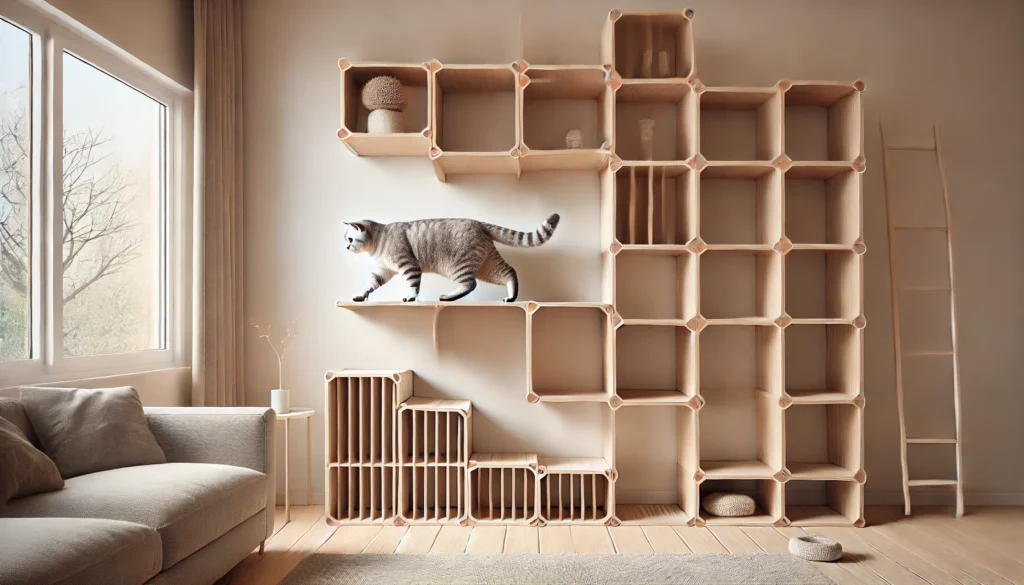Wall-mounted climbing shelves are an incredible way to give indoor cats vertical territory, exercise, and mental stimulation. But just because you’ve installed beautiful cat furniture doesn’t mean your cat will start using it right away. Many cats need encouragement, confidence-building, and positive reinforcement to explore vertical spaces comfortably.
This guide will walk you through how to train your cat step-by-step to safely and happily use climbing shelves and wall-mounted perches in your home.
Why Climbing Is Important for Indoor Cats
Vertical climbing mimics natural feline behaviors and supports overall well-being:
- Offers escape routes in multi-pet homes
- Reduces floor-level stress and conflict
- Provides exercise, muscle strengthening, and joint mobility
- Stimulates mental curiosity and confidence
- Gives cats a sense of control over their environment
Adding climbing shelves turns empty wall space into a functional feline playground.
Choose the Right Type of Wall Shelves
Before training begins, make sure your shelves are:
- Made of sturdy, weight-rated materials (wood, metal, or strong plastic)
- Wide enough for your cat to sit, stretch, and turn (usually 8–12 inches deep)
- Textured or carpeted for grip
- Installed securely in wall studs or with heavy-duty anchors
- Accessible (start low and gradually go higher)
Avoid slippery, unstable, or overly narrow shelves, especially for senior or nervous cats.
Plan a Logical Shelf Layout
A shelf system should make sense from your cat’s perspective. They should be able to:
- Reach the first shelf easily (via furniture or a small jump)
- Move up and down gradually with staggered heights
- Access a safe “exit” route without getting stuck
- See the room or window from the highest point
A zigzag or ladder-style pattern works best. Avoid placing shelves near doors, loud appliances, or direct heat sources.
Step 1: Let Your Cat Observe the New Setup
Don’t place your cat on the shelves immediately. Instead:
- Let them sniff and investigate at their own pace
- Sprinkle catnip or silvervine on the lower shelf
- Place their favorite toy or treat nearby
- Sit on the floor and encourage calm curiosity
Avoid loud encouragement or physical pressure. Patience leads to longer-lasting success.
Step 2: Use Treats or Toys to Lure Exploration
When your cat shows interest in the shelf, guide them up gently using:
- Wand toys to simulate climbing prey
- Treat trails placed just above paw height
- Clicker training with verbal praise and small food rewards
Reward even small progress: touching the shelf, jumping up, or simply looking up with interest.
Step 3: Build Confidence with Repetition
Repeat short training sessions daily (5–10 minutes) to build familiarity.
- Use positive reinforcement every time they engage
- Avoid yelling, rushing, or startling your cat near the shelves
- Add scratching posts or climbing-friendly textures nearby to encourage vertical activity
Eventually, your cat will start using the shelves on their own terms.
Step 4: Encourage Use With Daily Habits
Turn the shelf into a destination by associating it with positive daily moments.
- Feed meals or offer treats on the shelf
- Place toys, kickers, or puzzle feeders there
- Add a soft pad or bed to create a cozy napping spot
- Use it as part of playtime: toss toys or laser pointers across it
The more purpose the shelf serves, the more your cat will use it.
Step 5: Use Vertical Territory in Multi-Cat Homes
Climbing shelves help manage tension between cats by offering separate zones.
- Install multiple levels or shelves in different corners
- Offer several “top” positions so cats don’t fight over the highest spot
- Reward each cat individually for using the shelves
- Use scent-swapping or synchronized treat time to reduce competition
Cats feel more confident when they can claim their own elevated space.
Troubleshooting Common Issues
Your cat ignores the shelves:
Try moving a familiar item (blanket, toy) to the shelf. Lower the height and increase visibility.
Your cat only uses the first level:
Build upward over time. Use treats or toys to lure them to the next level.
Your cat slips or jumps off awkwardly:
Add texture to shelves for grip. Ensure spacing allows natural climbing motion.
Your cat seems afraid of falling:
Place a carpeted surface or rug beneath the setup to soften perceived danger.
Safety and Maintenance Tips
- Check shelf bolts and brackets monthly for stability
- Vacuum or wipe surfaces to remove hair and dust
- Avoid overloading shelves with decorations or multiple pets
- If your cat has mobility issues, keep shelves low or provide ramps
Safety ensures your cat can use their vertical space freely and confidently.
Enrich Your Cat’s World — One Shelf at a Time
Indoor cats thrive when given vertical opportunities to explore, rest, and observe. Training your cat to use climbing shelves doesn’t have to be complicated — with patience, treats, and smart setup, your feline will soon be mastering their own wall-mounted kingdom.
Whether you live in a studio apartment or a multi-level home, climbing shelves can transform your space into a feline-friendly paradise.






